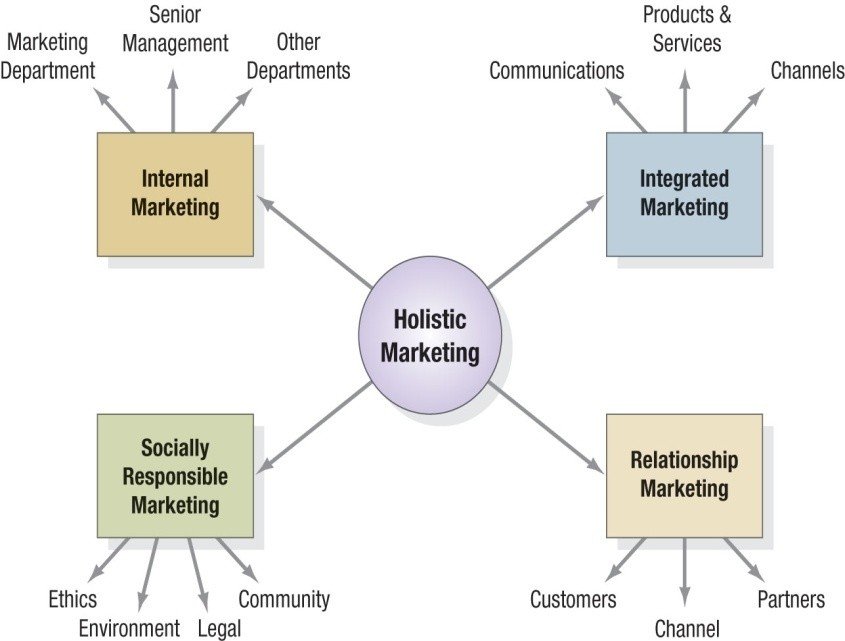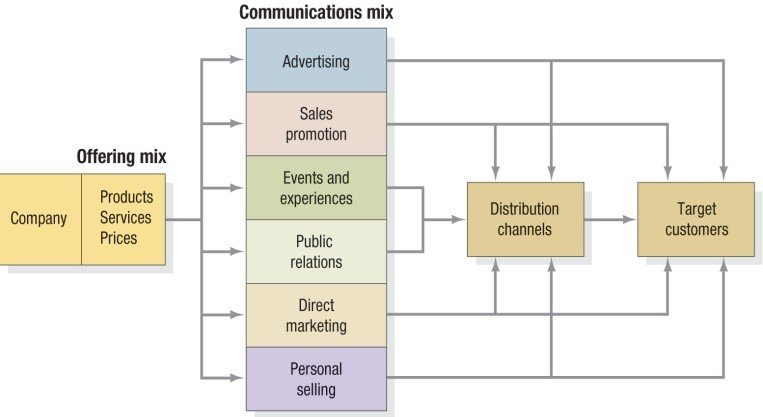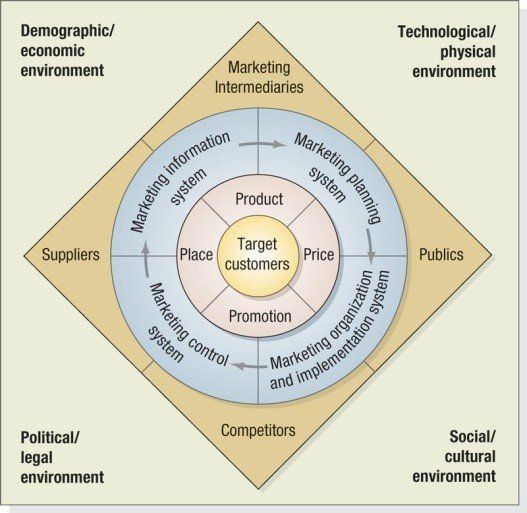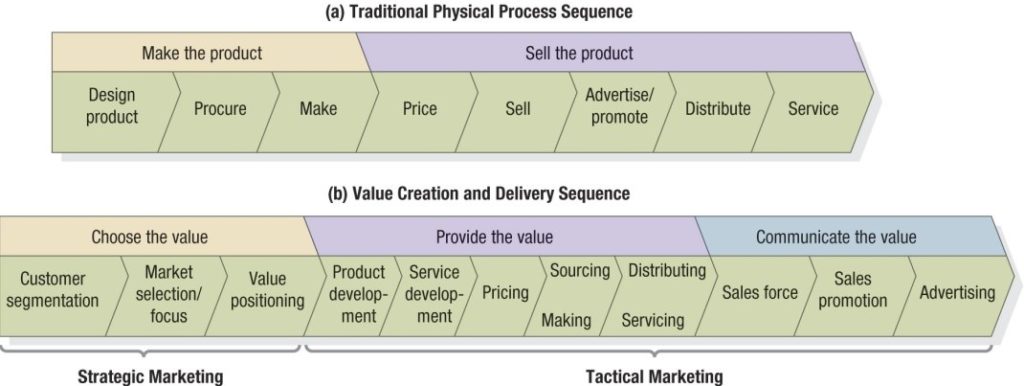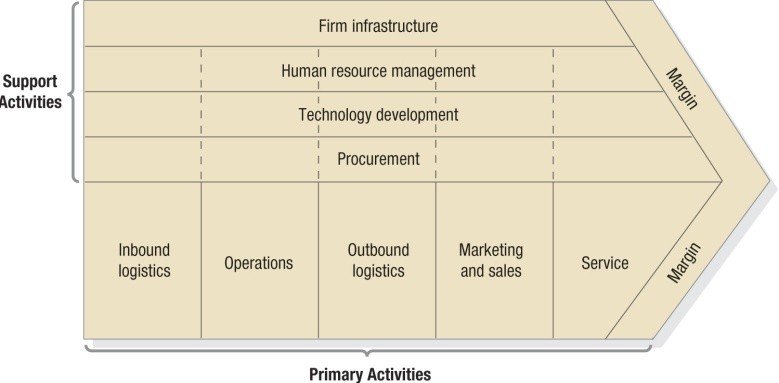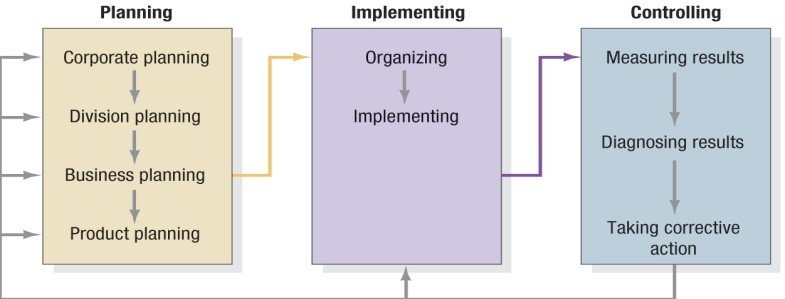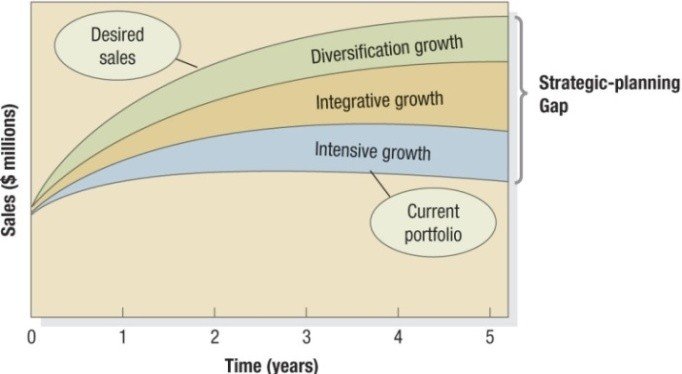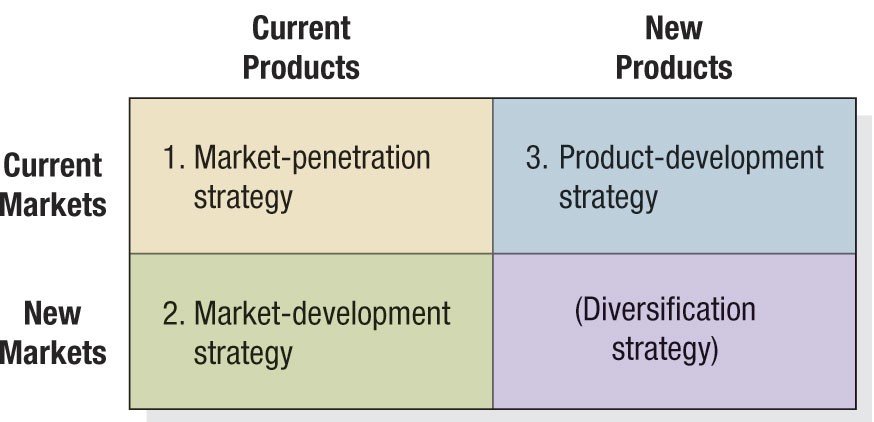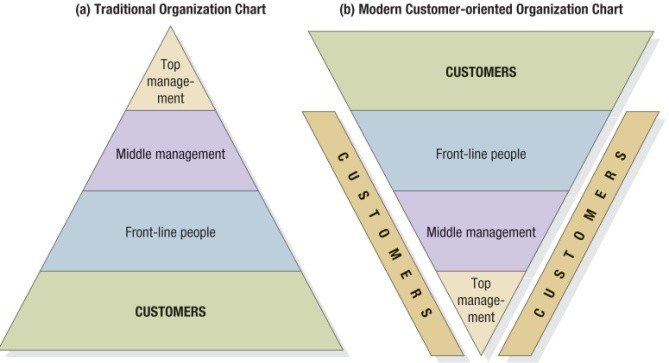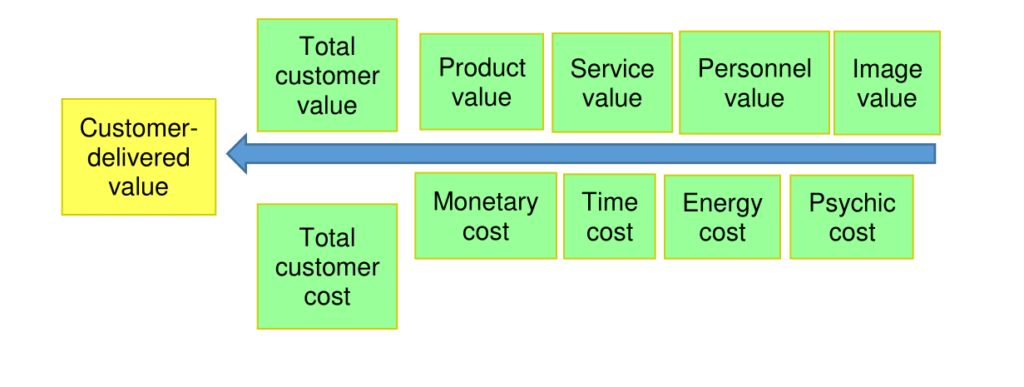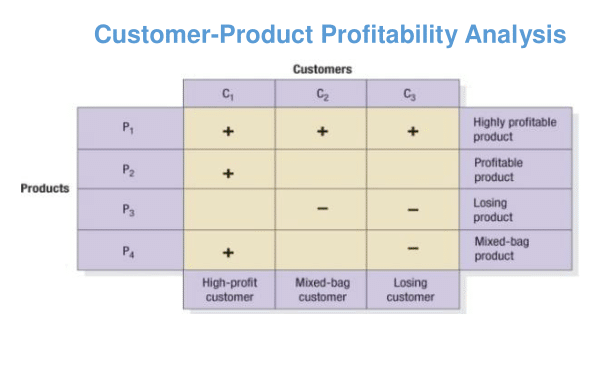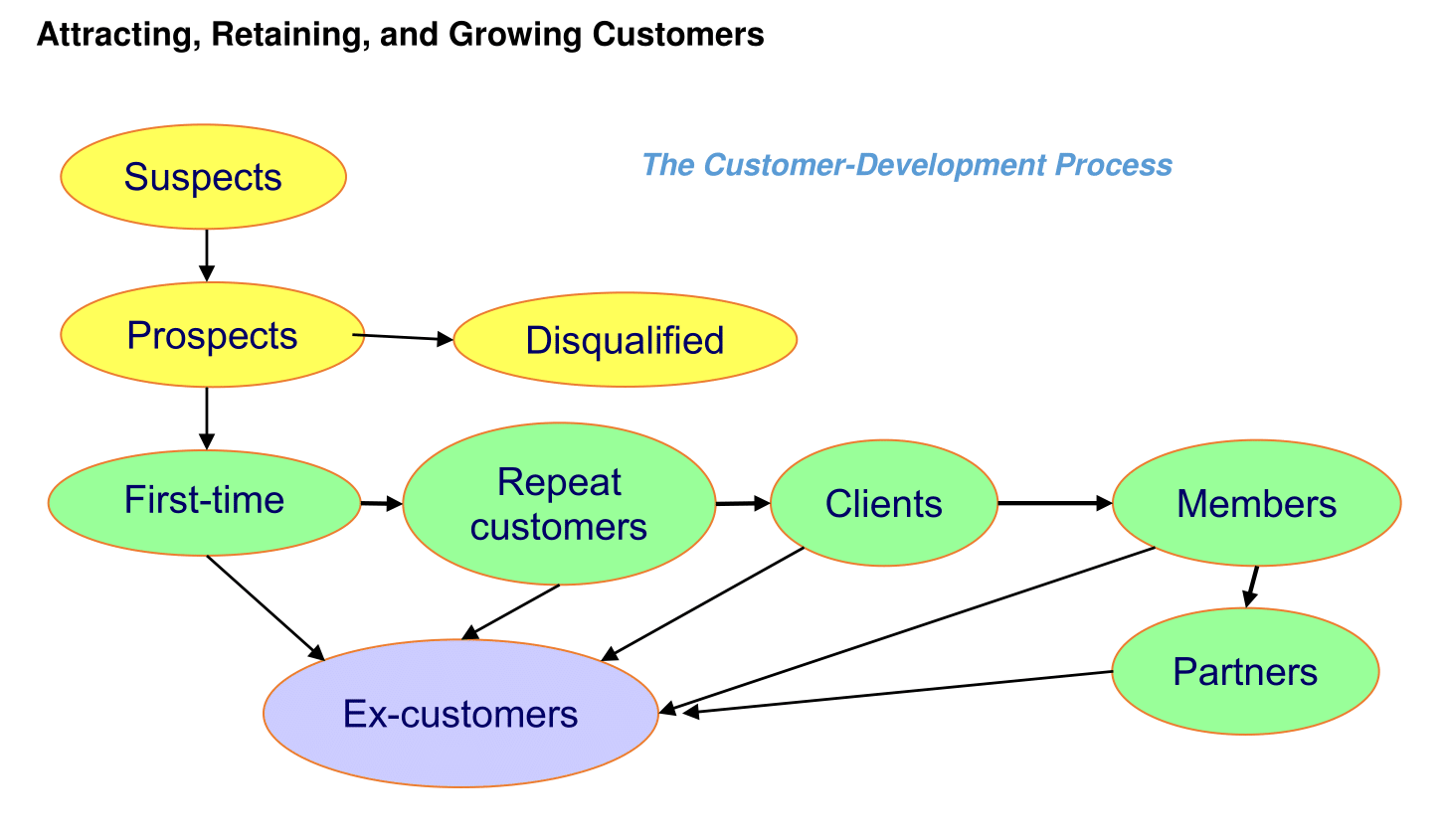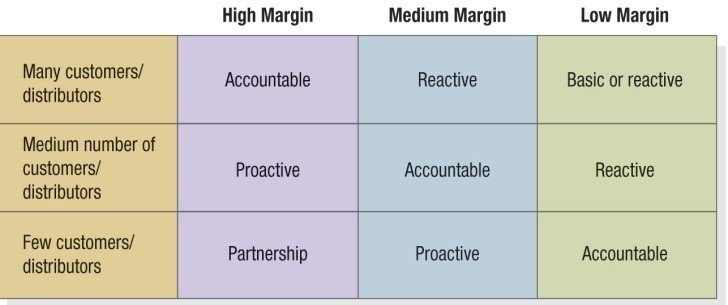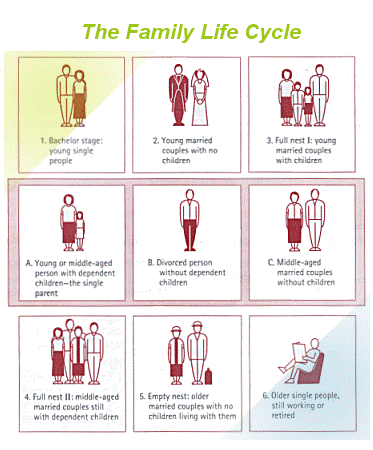Marketing
Defining Marketing for the 21st Century
The Importance of Marketing
Marketing
- deals with identifying and meeting human and social needs
- “meeting needs profitably”
- An organizational function and a set of processes for creating, communicating, and delivering value to customers and for managing customer relationships in ways that benefit the organization and its stakeholders
Marketing management
- the art and science of choosing target markets and getting, keeping, and growing customers through creating, delivering, and communicating superior customer value
- “the art of selling products”
- “Ideally, marketing should result in a customer who is ready to buy.” (Peter Drucker)
Exchange – the core of marketing; the process of obtaining a desired product form someone by offering something in return
Transaction – is a trade of values between two or more parties
*Marketing consists of actions undertaken to elicit desired responses from a target audience
WHAT IS MARKETED?
- Goods
- Services (i.e. airlines, hotels, car rental, barbers…)
- Events (concerts, trade shows)
- Experiences (Disney World, customized experiences)
- Persons (celebrity marketing)
- Places (cities, tourist attractions)
- Properties (real estate or financial property – stocks and bonds)
- Organizations (universities, museums, performing arts orgs, non-profit orgs.)
- Information (encyclopedias, magazine)
- Ideas (“Friends Don’t Let Friends Drive Drunk)
WHO MARKETS?
Marketers and Prospects
- Marketer
– someone who seeks a response from another party, called prospects
- Skilled in stimulating demand for a company’s products
- Responsible for demand management
- Seek to influence the level, timing, and composition of demand to meet the organization’s objectives
- 8 Possible Demand States:
- Negative demand - Consumers dislike the product and may even pay a price to avoid it
- Nonexistent demand - Consumers may be unaware or uninterested in the product.
- Latent demand - Consumers may share a strong need that cannot be satisfied by an existing product.
- Declining demand - Consumers begin to buy the product less frequently or not at all.
- Irregular demand - Consumer purchases vary on a seasonal, monthly, weekly, daily, or even hourly basis.
- Full demand - Consumers are adequately buying all products put into the marketplace
- Overfull demand - More consumers would like to buy the product than can be satisfied.
- Unwholesome demand - Consumers may be attracted to products that have undesirable social consequences.
Markets – marketers often use the term market to cover various grouping of customers
- Needs markets
- Product markets
- Demographic markets
- Geographic markets
- Voter markets
Key Customer Markets
- Consumer Markets – companies selling mass consumer goods and services spend a great deal of time trying to establish a superior brand image
- Brand strength depends on developing a superior product and packaging, ensuring its availability, and backing it with engaging communication and reliable service
- Business Markets – companies selling business goods and services often face well-trained and well-informed professional buyers who are skilled in evaluating competitive offerings
- Business marketers must demonstrate how their products will help these buyers achieve higher revenue or lower costs
- Global Markets - companies selling goods and services in the global marketplace face additional decisions and challenges
- Which countries to enter; how to enter each country’ how to adapt their product and service features to each country; how to price in different countries’ how to adapt their communication to fit different cultures
- Non-Profit and Governmental Markets
MARKETPLACES, MARKETSPACES, AND METAMARKETS
- Marketplace – physical
- Marketspace – digital
- Metamarket – cluster of complementary products and services that are closely related in the minds of consumers but are spread across a diverse set of industries
- (i.e. automobile – car dealers, financing, insurance, mechanics, spare parts dealers, service shops, auto mags, classified ads, auto sites on internet)
- “marketplace isn’t what it used to be” / How business and marketing are changing:
a. Changing technology
b. Globalization
c. Deregulation
d. Privatization
e. Customer empowerment
f. Customization
g. Heightened competition
h. Industry convergence
i. Retail transformation (growing power of giant retailers and “category killers”)
j. Disintermediation (i.e. in delivery of products and services – amazon, yahoo, eBay, etrade)
Company Orientations Towards the Marketplace
1. The Production Concept
- Consumers will prefer products that are widely available and in inexpensive
- Managers: to concentrate on achieving high production efficiency, low costs, and mass distribution
2. The Product Concept
- Consumers will favor those products that offer the most quality, performance, or innovative features
- Managers: focus on making superior products in improving them over time
3. The Selling Concept
- Consumers and businesses, if left alone, will ordinarily not buy enough of the organization’s products
- Orgs must, therefore, undertake an aggressive selling and promotion efforts
- Practice most aggressively with unsought goods: encyclopedias, insurance, funeral plots
4. The Marketing Concept
- Instead of product-centered, “make-and-sell” philosophy,
- business shifted to a customer-centered, “sense-and-respond” philosophy
- Marketing is finding the right products for your customers
- Focus on the needs of the buyer
- Satisfying the needs of the customer by means of the product and the whole cluster of things associated with creating delivering and finally consuming it
5. The Holistic Marketing Concept
- “everything matters” with marketing – broad, integrated perspective is often necessary
- Four components of Holistic Marketing:
a. Relationship Marketing – building mutually satisfying long-term relationships with key parties
b. Integrated Marketing – devise marketing activities and assemble fully integrated marketing programs to create, communicate, and deliver value for consumers
*marketing activities come in all forms; one ex. Is in terms of marketing mix:
*figure below shows the company preparing an offering mix of products and services, and prices, and utilizing a communications mix:
c. Internal Marketing - ensuring that everyone in the organization embraces appropriate marketing principles, especially senior management
Must take place on two levels:
• Various marketing functions must work together (sales force, advertising, CS, product management, market research)
• Marketing must be embraced by the other departments; they must also “think customer”; marketing must be pervasive throughout the company)
d. Social responsibility marketing – understanding broader concerns and the ethical, environmental, legal, and social context of marketing activities and programs
Fundamental Marketing Concepts, Trends, and Tasks
Core Concepts
NEEDS, WANTS, AND DEMANDS
- Needs: basic human requirements
- Wants: needs become wants when they are directed to specific objects that might satisfy the need
- Demands: wants for specific products backed by an ability to pay
- Marketers do not create needs: Needs preexist marketers. Marketers, along with other societal factors, influence wants.
- “Simply giving customers what they want isn’t enough anymore – to gain an edge companies must help customers learn what they want.”
Five types of needs:
1.) Stated needs 2)Real needs 3)Unstated needs 4)Delight needs 5)Secret needs
TARGET MARKETS, POSITIONING, AND SEGMENTATION
- A marketer can rarely satisfy everyone in a market
- Marketers start by dividing up the market into segments
- Decides which segments present the greatest opportunity – target markets
- For each chosen target market, firm develops a market offering
- Offering is positioned in the minds of the target buyers as delivering some central benefit(s).
- For each chosen target market, firm develops a market offering
- Decides which segments present the greatest opportunity – target markets
- Marketers start by dividing up the market into segments
OFFERING AND BRANDS (value propositions)
- Offering: can be a combination of products, services, information, and experiences
- Brand: an offering from a known source
VALUE AND SATISFACTION
- Offering will be successful if it delivers value and satisfaction to the target buyer.
- Value
- reflects the perceived tangible and intangible benefits and costs to customers
- a central marketing concept; Marketing can be seen as the identification, creation, communication, delivery, and monitoring of customer value
- “customer value triad” – (qsp) value can be seen a primarily a combination of quality, service, and price
- Satisfaction – person’s comparative judgments resulting from a product’s perceived performance in relation to his expectations.
3 KINDS OF MARKETING CHANNELS:
- Communication channels deliver and receive messages from target buyers
- Distribution channels – used to display, sell, or deliver the physical product or service(s) to buyer or user.
- Service channels - used to carry out transactions with potential buyers
SUPPLY CHAIN
- Stretching from raw materials to components to final products that are carried to final buyers
- Represents a value delivery system
COMPETITION
- Includes all the actual and potential rival offerings and substitutes that a buyer might consider
MARKETING ENVIRONMENT
- Task environment – includes the immediate actors involved in producing, distributing, and promoting the offering
-
- Company, suppliers, distributors, dealers, and target customers
-
- Broad environment consist of six components:
- Demographic environment
- Economic environment
- Physical environment
- Technological environment
- Political-legal environment
- Social-cultural environment
Factors Influencing Company Marketing Strategy
MARKET PLANNING – consists of:
- analyzing marketing opportunities;
- selecting target markets;
- designing marketing strategies;
- developing marketing programs; and
- managing the marketing effort
14 Shifts in Marketing Management
| FROM | TO |
| 1. Marketing does the marketing | Everyone Does the Marketing |
| 2. Organizing by product units | Organizing by customer segments |
| 3. Making everything | Buying more goods and services from outside |
| 4. Using many suppliers | Working with fewer suppliers in a “partnership” |
| 5. Relying on old market positions | Uncovering new ones |
| 6. Emphasizing tangible assets | Emphasizing intangible assts |
| 7. Building brands through ads | Building brands through performance and integrated communications |
| 8. Attracting customers through stores and salespeople | Making products available online |
| 9. Selling to everyone | Trying to be the best firm serving well-defined target markets |
| 10. Focusing on profitable transactions | Focusing on customer lifetime value |
| 11. Focus on gaining market share | Focus on building customer share |
| 12. Being local | Being “glocal” - both global and local |
| 13. Focusing on the financial scorecard | Focusing on the marketing scorecard |
| 14. Focusing on shareholders | Focusing on stakeholders |
Marketing Management Tasks
- Developing marketing strategies and plans
- Capturing marketing insights
- Connecting with customers
- Building strong brands
- Shaping the market offerings
- Delivering value
- Communicating value
- Creating long-term growth
Developing Marketing Strategies and Plans
Marketing and Customer Value
The Value Delivery Process
- STP (“segmentation, targeting, positioning”) – the essence of strategic marketing
- 3 V’s Approach to Marketing:
- Define the value segment
- Define the value proposition
- Define the value network
The Value Chain
Porter's Generic Value Chain
-
-
- Michael Porter proposed the value chain as a tool for identifying ways to create more customer value
- Every firm is a synthesis of activities performed to design, produce, market, deliver, and support its product
- The firm’s task is to examine its costs and performance in each value-creating activity and to look for ways to improve it
- Benchmark (org costs & performance measures; competitor costs & performance measures)
- Study the “best of class” practices of the world’s best companies
- To be successful, a firm also needs to look for competitive advantages beyond its own operations, into the value chains of suppliers, distributors, and customers
- Study the “best of class” practices of the world’s best companies
-
Porter's Generic Value Chain
Core Competencies
-
- To carry out its core business processes, a company needs resources
- The key then is to own, and nurture the resources and competencies that make up the essence of the business
- To carry out its core business processes, a company needs resources
3 characteristics of Core Competencies:
- Source of competitive advantage
- Has applications in a wide variety of markets
- Difficult for competitors to imitate
- Competitive advantage ultimately derives from how well the company has fitted its core competencies and distinctive capabilities into tightly interlocking “activity systems.”
A Holistic Marketing Orientation and Customer Value
- Value Exploration
- Cognitive space: reflects existing and latent needs; need for participation, stability, freedom, change
- Competency space: in terms of breadth (broad vs. focused scope of business) and depth (physical vs. knowledge-based cap.)
- Resource space: involves horizontal partnerships and vertical partnerships
- Value Creation
- Value Delivery
The Central Role of Strategic Planning
- Strategic planning calls for action in 3 areas:
- Managing a company’s businesses as an investment portfolio
- Assessing each business’s strength by considering the market’s growth rate and the company’s position and fit in that market
- Establishing a strategy (develop a game plan for its long-run objectives)
- Marketing plan: central instrument for directing and coordinating the marketing effort
- Strategic marketing plan
- lays out the target markets and the value proposition that will be offered, based on an analysis of the best market opportunities
- Tactical marketing plan
- specifies the marketing tactics, including product features, promotion, merchandising, pricing, sales channels, and service
- Strategic marketing plan
- Marketing plan: central instrument for directing and coordinating the marketing effort
Corporate and Division Strategic Planning
The Strategic Planning, Implementation, and Control Processes
- Defining the Corporate Mission
- Mission statements –
- Provides employees with a shared sense of purpose, direction, and opportunity
- What is our business? Who is the customer? What is of value to customer? What will our business be? What should our business be? (Peter Drucker)
- Mission statements –
- Defining the Business
- Business can be defined in terms of 3 dimensions: customer groups, customer needs, and technology
- SBUs: The purpose of identifying the company’s strategic business units is to develop separate strategies and assign appropriate funding
- Assessing Growth Opportunities
- Identify opportunities to achieve further growth within current businesses (intensive opportunities)
- Identify opportunities to build or acquire businesses that are related to current businesses (integrative)
- Identify opportunities to add attractive businesses that are unrelated to current businesses (diversification opportunities)
- Integrative Growth – a business’s sales and profits may be increased through backward, forward, or horizontal integration within its industry
- Diversification Growth – makes sense when good opportunities can be found outside the present businesses
- Concentric strategy – seek new products that have technological or marketing synergies with existing product lines
- Horizontal strategy – search new products that could appeal to current customers even though the new products are technologically unrelated to its current product line
- Conglomerate strategy – seek now businesses that have no relationship to its current technology, products, or markets
- Downsizing and Divesting older business
Business Unit Strategic Planning
- Business Mission
- SWOT analysis
- Goal formulation
- Strategy Formulation
- Porter’s Generic Strategies:
- Overall cost leadership
- Differentiation
- Focus
- Strategic Alliances
- Marketing Alliance:
- Product or service alliances
- Promotional alliances
- Logistics alliances
- Pricing collaborations
- Program Formulation and Implementation
- McKinsey & Company’s 7s in Successful Business Practice:
- Strategy, structure, and systems (“hardware” of success)
- Style, skills, staff, and shared values (“software” of success)
- Marketing Alliance:
Feedback and Control – track the results and monitor new developments
Product Planning: The Nature and Contents of a Marketing Plan
Contents of a Marketing Plan (sample):
- Executive summary and table of contents
- Situational analysis
- Market Summary
- Target Markets
- Market Demographics
- Geographic
- Demographic
- Behavior Factors
- Market Needs
- Market Trends
- Market Growth
- SWOT Analysis
- Competition
- Product Offering
- Keys to Success
- Critical Issues
- Market Summary
- Marketing strategy
- Mission
- Marketing objective
- Financial objective
- Target markets
- Positioning
- Strategies
- Marketing Mix
- Marketing Research
- Financial projections
- Break-even Analysis
- Sales Forecast
- Expense Forecast
- Implementation controls
- Controls
- Implementation
- Marketing Organization
- Contingency Planning
Gathering Information and Scanning the Environment
Components of a Modern Marketing Information System
- Marketing Information Systems (MIS)
- Consists of people, equipment, and procedures to gather, sort, analyze, evaluate, and distribute needed, timely and accurate information to marketing decision makers
- Components:
- Internal company records, marketing intelligence activities
- Marketing research
- MIS should be a cross between what mangers think they need, what managers really need, and what is economically feasible
Internal Records and Marketing Intelligence
- The Order-to-Payment Cycle
- Heart of the internal records system
- Sales Information Systems
- Companies must carefully interpret the sales data so as not to get the wrong signals
- Databases, Data Warehousing, and Data Mining
- The Marketing Intelligence System
- Internal records system supplies data; marketing intelligence system supplies happenings data
- A set of procedures and sources managers use to obtain everyday information about developments in the marketing environment
Analyzing the Macroenvironment
- Needs and Trends
- Fad: “unpredictable, short-lived, and without social, economic, and political significance.”
- Trend: a direction or sequence of events that has some momentum and durability
- Reveals the shape of the future and provides many opportunities
- Megatrend: “large social, economic, political and technological changes that are slow to form, and once in place, they influence us for some time – between seven and ten years, or longer.”
- A new product or marketing program is likely to be more successful if it is in line with strong trends rather than opposed to them, but detecting a new market opportunity does not guarantee success, even if it is technically feasible.
- Identifying the Major Forces
- Represent “noncontrollables,” which company must monitor and to which it must respond
6 Major Forces:
- Demographic
- Economic
- Social-cultural
- Natural
- Technological
- Political-legal
1. Demographic Environment
- Demographic trends are highly reliable for the short and intermediate run
- Worldwide Population Growth
- A growing population does not mean growing markets unless these markets have sufficient purchasing power
- Example: China’s one child policy - consequence: “little emperors” or “six pocket syndrome”
- A growing population does not mean growing markets unless these markets have sufficient purchasing power
- Population Age Mix
- Growing trend toward an aging population
- For marketers, the most populous age groups shape the marketing environment (US: baby boomers, Gen. X, Gen. Y)
- Ethnic and Other Markets
- Japan mostly Japanese; US – “salad bowl” society”
- Ethnic groups have certain specific wants and buying habits
- Must be careful not to overgeneralize about ethnic groups
- Within each ethnic group are consumers who are quite different from each other
- Diversity goes beyond ethnic and racial markets
- Educational Groups
- 5 Groups: illiterates, high school dropouts, hs diplomas, college degrees, and professional degrees
- Household Patterns
- “traditional household” - consists of a husband, wife, and children
- “diverse” or “nontraditional” – single live-alones, adult live-together of one or both sexes, single-parent families, childless married couples, and empty-nesters
- Consider the special needs of nontraditional households, because they are now growing more rapidly than traditional households
- Geographical Shifts in Population
- Period of migratory movements between and within countries
- Location makes a difference in goods and service preference
2. Economic Environment
- Income distribution
- Marketers often distinguish countries with 5 income-distribution patterns:
- Very low incomes
- Mostly low incomes
- Very low, very high incomes
- Low, medium, high incomes
- Mostly medium incomes
- Marketers often distinguish countries with 5 income-distribution patterns:
- Savings, Debt, and Credit Availability (affects consumer expenditures)
- Outsourcing and Free Trade
3. Social-Cultural Environment
- Society shapes the beliefs, values, and norms that largely define the tastes and preference
- Views of themselves
- Views of others
- Views of organizations
- Views of society
- Views of nature (harmony or mastery over nature)
- Views of universe
- High persistence of core cultural values
- Marketers have some chance of changing secondary values but little chance of changing core values
- Existence of Subcultures
- Groups with shared values emerging from their special life experiences or circumstances
- Shifts of Secondary Cultural Values through time
- Cultural swings do take place (i.e. hippies, the Beatles…)
4. Natural Environment (4 trends in the natural environment)
- Shortage of Raw Materials
- Increased Energy Costs
- Anti-Pollution Pressures
- Changing Role of Governments
5. Technological Environment (Every new technology is a force for “creative destruction.”)
- Accelerating pace of change
- Unlimited opportunities for innovation
- Varying R&D Budgets
- Increased regulation of technological change
6. Political-legal Environment
- Increase in business legislation
- Growth of special-interest groups
Conducting Marketing Research and Forecasting Demand
The Market Research System
- The systematic design, collection, analysis, and reporting of data and findings relevant to a specific marketing situation facing the company
- Types of Marketing Research Firms:
- Syndicated-service firms
- Custom marketing research firms
- Specialty-line marketing research firms
The Marketing Research Process
- Research approaches (primary data can be collected in 5 main ways)
-
- Observational research
- Focus group research
- Survey research
- Behavioral data
- Experimental research
-
- Research instruments
- Questionnaires
- Qualitative Measures – for gauging consumer opinion because consumer actions do not always match their answers to survey questions
- Shadowing
- Behavior mapping
- Consumer journey
- Camera Journals
- Extreme user interview
- Storytelling
- Unfocus groups
- Mechanical Devices (example: galvanometers and tachistoscope, eye cameras, audiometers, gps)
- Sampling Plan (sampling unit? Sampling size? Sampling procedure?)
- Contact Methods
- Mail questionnaires
- Telephone interview
- Personal interview
- Online interview
- Characteristics of Good Marketing Research:
- Scientific method
- Research creativity
- Multiple methods
- Interdependence
- Value and cost of information
- Healthy skepticism
- Ethical marketing
Measuring Marketing Productivity
Marketing Metrics
| External | Internal |
|
|
Measuring Marketing Plan Performance
- Sales analysis
- Market share analysis
- Marketing expense-to-sales analysis
- Financial analysis
- Marketing-profitability analysis
- Determining corrective action
- Direct vs Full Costing
- Marketing-Mix Modeling – analyze data from a variety of sources, such as retailer scanner data, company shipment data, pricing, media, and promotion spending data,to understand more precisely the effect of specific marketing activities
Forecasting and Demand measurement
The Measures of Market Demand
- Potential market
- Available market
- Target market
- Penetrated market
A Vocabulary of Demand Measurement
- Market Demand
- The total volume that would be bought by a defined customer group in a defined geographical area in a defined time period in a defined marketing environment under a defined marketing program
- Market Forecast
- Market Potential
- The limit approached by market demand as industry marketing expenditures approach infinity for a given marketing environment
- Company Demand
- The company’s estimated share of market demand at alternative levels of company marketing effort in a given time period
- Company Sales Forecast
- Expected level of company sales based on a chosen marketing plan and an assumed marketing environment
- Company Sales Potential
- The sales limit approached by company demand as company marketing effort increases relative to that of competitors
Estimating Current Demand
- Total Market potential – maximum amount of sales that might be available to all the firms in an industry during a given period, under a given level of industry marketing effort and environmental condition
- Area Market Potential
- Market-Buildup Method
- Multiple-Factor Index Method
- Industry sales and Market Sales
Estimating Future Demand
- Survey of buyers’ intentions (forecasting, purchase probability scale)
- Composite of Sales Force Opinions
- Expert Opinion
- Past-Sales Analysis
- Market-test method
Creating Customer Value, Satisfaction, and Loyalty
Customer Perceived Value
- Customers tend to be value-maximizers, within the bounds of search costs and limited knowledge, mobility, and income
- Determinants of Customer-Delivered Value:
- Customer perceived value (CPV) – difference between the prospective customer’s evaluation of all the benefits and all the costs of an offering and the perceived alternatives
- Total Customer value –perceived monetary value of all bundle of economic, functional, and psychological benefits customers expect from a given market offering
- Total customer cost - bundle of costs customers expect to incur in evaluating, obtaining, using and disposing of the given market offering, including monetary, time, energy, and psychic costs.
- Customer perceived value is thus based on the difference between what the customer gets and what he or she gives for different possible choices.
- The marketer can increase the value of the customer offering by some combination of raising functional or emotional benefits and/or reducing one or more of the various types of costs
Delivering High Customer Value
The key to generating high customer loyalty is to deliver high customer value
- Loyalty – “a deeply held commitment to re-buy or re-patronize a preferred product or service in the future despite situational influences and marketing efforts having the potential to cause switching behavior”
- Value proposition – whole cluster of benefits the company promises to deliver
- Value-delivery system – includes all the experiences the customer will have on the way to obtaining and using the offering
Total Customer Satisfaction
- Ultimately, the company must operate on the philosophy that it is trying to deliver a high level of customer satisfaction subject to delivering acceptable levels of satisfaction to the other stakeholders, given its total resources.
- Customer Expectations – a customer’s decision to be loyal or to defect is the sum of many small encounters with the company
Measuring Satisfaction
- One key to customer retention is customer satisfaction
- High satisfaction, or delight, creates an emotional bond with the brand or company, not just a rational preference.
- Some methods used to measure customer satisfaction: Periodic surveys, customer loss rate, mystery shoppers
Product and Service Quality
- Satisfaction will also depend on product and service quality.
- Quality: the totality of features and characteristics of a product or service that bear on its ability to satisfy stated or implied needs (customer-centered definition)
- Seller has delivered quality whenever the seller’s product or service meets or exceeds the customers’ expectation
- Conformance quality
- Performance quality
- Total quality is the key to value creation and customer satisfaction
Total Quality Management (TQM)
- An organization-wide approach to continuously improving the quality of all the organization’s processes, products, and services.
- Higher levels of quality result in higher levels of customer satisfaction, which support higher prices and (often) lower costs.
- Studies have shown a high correlation between relative product quality and company profitability.
Maximizing Customer Lifetime Value
- Ultimately, marketing is the art of attracting and keeping profitable customers
- 20-80 rule: the top 20% of the customers may generate as much as 80% of the company’s profits
Customer-Product Profitability Analysis
Customer Profitability
- Profitable Customer – a person, household, or company that over time yields alifetime revenue stream that exceeds by an acceptable amount the company’s cost stream of attracting, selling ,and servicing that customer
- Customer profitability analysis (CPA)
- The company estimates all revenue coming from the customer, less all costs
- Marketers must segment customers into those worth pursuing versus those potentially less lucrative customers that should receive less attention, if any at all
- Competitive Advantage – company’s ability to perform in one or more ways that competitors cannot or will not match
- Leverageable advantage - on that a company can use as a springboard to new advantages
- Any competitive advantage must be seen by customers as a customer advantage
Customer-Product Profitability Analysis
Measuring Customer Lifetime Value
- Customer Lifetime Value (CLV) – the net present value of the stream of future profits expected over the customer’s lifetime purchases
Customer Equity - the total of the discounted lifetime values of all of the firm’s customers; the more loyal the customer, the higher the customer equity
- 3 Drivers of Customer Equity:
- Value equity – customer’s objective assessment of the utility of an offering based on perceptions of its benefits relative to its costs
- Brand equity – customer’s subjective and intangible assessment of the brand, above and beyond its objectively perceived value
- Relationship equity - customer’s tendency to stick with the brand, above and beyond objective and subjective assessments of its worth
- Customer equity notions can be extended
- Relational equity of the firm – the cumulative value of the firm’s network of relationships with its customer, partners, suppliers, employees, and investors.
Cultivating Customer Relationships
- Maximizing customer value means cultivating long-term customer relationships
- Companies are now moving away from wasteful mass marketing to more precision marketing designed to build strong customer relationships
- Mass customization - the ability of a company to meet each customer’s requirements – to prepare on a mass basis individually designed products, services, programs, and communications
Customer Relationship Management (CRM) – the process of managing detailed information about individual customers and carefully managing all customer “touch points” (any occasion on which a customer encounters the brand and product) to maximize customer loyalty
- Identify prospects and customers
- Differentiate customers by needs and value to company
- Interact to improve knowledge
- Customize for each customer
Attracting, Retaining, and Growing Customers
The Customer-Development Process
- The challenge is to produce delighted and loyal customers
- 2 main ways to strengthen customer retention:
- Erect high switching barriers
- Deliver high customer satisfaction
- 96% of dissatisfied customers don’t complain; they just stop buying
- Market Dynamics:
- Permanent Capture Markets – once a customer, always a customer
- Simple Retention Markets – customers can permanently be lost after each period
- Customer Migration Markets – Customers can leave and come back
Building Loyalty
- 5 different levels of investment in customer relationship building (see figure):
Basic marketing; Reactive marketing; Accountable; Proactive; Partnership
Levels of Relationship Marketing
Reducing Customer Defection
Levels of Relationship Marketing
- Define and measure retention rate.
- Distinguish causes of customer attrition.
- Estimate profit loss associated with loss of customers.
- Assess cost to reduce defection rate.
- Gather customer feedback.
Forming Strong Customer Bonds
- Retention building approaches:
- Adding Financial Benefits
- Adding Social Benefits
- Adding Structural Ties
Customer Databases and Database Marketing
- Customer database – an organized collection of comprehensive information about individual customers or prospects that is current, accessible, and actionable for such marketing purposes as lead generation, lead qualification, sale of a product or service, or maintenance of customer relationships
-
- Customer mailing list, business database
-
- Database marketing - the process of building, maintaining, and using customer databases and other databases (products, suppliers, resellers) for the purpose of contacting, transacting, and building customer relationships
- Data warehouse – data collected by the company and organized
- Datamining - useful information about individuals, trends, and segments from the mass of data are extracted my marketing statisticians
- Use the databases to:
- Identify prospects
- Decide which customers should receive a particular offer
- Deepen customer loyalty
- Reactivate customer purchases
- Avoid serious customer mistakes
- Downside of Database Marketing and CRM
- Building and maintain a customer database requires a large in vestment
- Difficult to collect the right data, especially to capture all the occasions of company interaction with individual customers
- Building a customer database would not be worthwhile in where:
- Product is once-in-a-lifetime purchase
- Customers show little loyalty to brand
- Unit sale is very small
- Cost of gathering information is too high
- Difficulty of getting everyone in the company to be customer-oriented and to use the available information
- Not all customers want a relationship with the company, and they may resent knowing that the company has collected that much personal information about them
- Assumptions behind CRM may not always hold true
- It may not be the case that it costs less to serve more loyal customers
- Building and maintain a customer database requires a large in vestment
Analyzing Consumer Markets
What Influences Consumer Behavior?
- Cultural Factors
- Culture – fundamental determinant of a person’s wants and behavior
- Subcultures – provide more specific identification and socialization for their members
- Social classes – a form of human societies exhibiting social stratification
-
- Tend to behave more alike than persons from two different social classes
- Persons are perceived as occupying inferior or superior positions according to social class
- Indicated by a cluster of variables (i.e. occupation, income, education, value orientation – rather than by any single variable
- Individuals can move up or down the social-class ladder during their lifetimes
- Social classes show distinct product and brand preferences in many areas
- Social classes differ in media preferences
-
- Social Factors
- Reference Groups – consist of all the groups that have direct (face-to-face) or indirect influence on his/her attitudes or behavior
- Membership group – groups having direct influence
- Primary groups (such as family, friends, neighbors, co-workers) - those with whom the person interacts fairly continuously and informally
- Secondary groups (such as religious, professional, and trade-union groups) – tend to be more formal and require less continuous interaction
- People are significantly influenced by their reference groups in at least 3 ways:
- Reference groups exposes an individual to new behaviors and lifestyles, and
- influence attitudes and self-concept
- create pressures for conformity that may affect actual product and brand choices
- People are also influenced by groups to which they do not belong:
- Aspirational group – those a person hopes to join
- Dissociative groups – those whose values or behavior an individual rejects
- Manufactures of products and brands where group influence is strong must determine how to reach and influence opinion leaders in these reference groups
- Membership group – groups having direct influence
- Family – most important consumer buying organization in society
-
- Family of orientation: parent and siblings
- Family of procreation: one’s spouse and children
- Marketers are interested in the roles and relative influence of family members in the purchase of la large variety of products and services
- …women actually buy more technology than men do
- Men and women may respond differently to marketing messages
- Shift in buying patterns: increase in the amount of dollars spent and the direct and indirect influence wielded by children and teens
-
- Roles and Statuses
- Role – consists of the activities a person is expected to perform
- Status – Each role carries a status
- People choose products that reflect and communicate their role and actual or desired status in society (i.e. status symbol potential of products and brands)
- Reference Groups – consist of all the groups that have direct (face-to-face) or indirect influence on his/her attitudes or behavior
- Personal Factors (have direct impact on consumer behavior)
- Age and Stage in the Life Cycle
- Taste in food, clothes, furniture, and recreation is often age related
- Consumption is also shaped by the family life cycle and the number, age, and gender of people in the household at any point in time
- Psychological life-cycle stages
- Adults experience certain “passages” or “transformations” as they go through life
- Age and Stage in the Life Cycle

